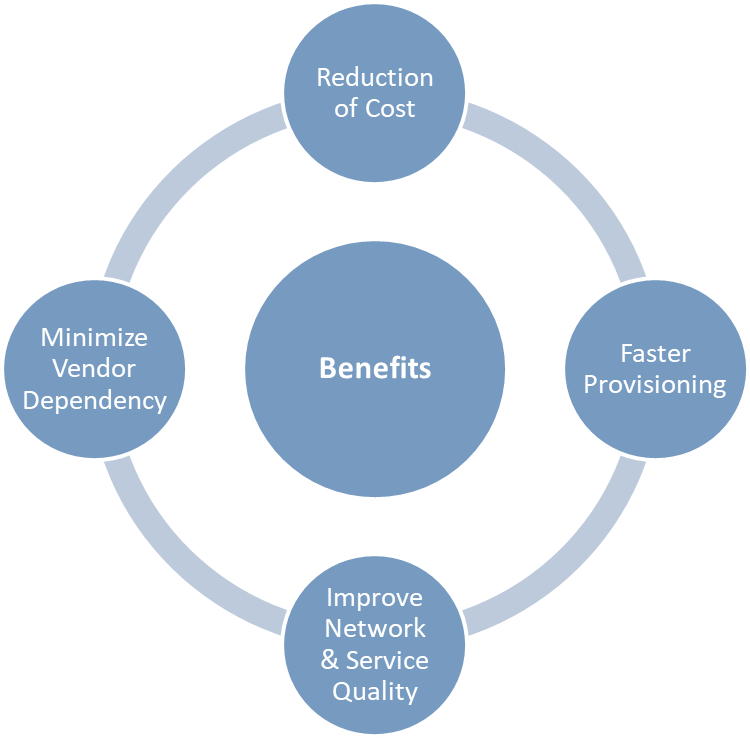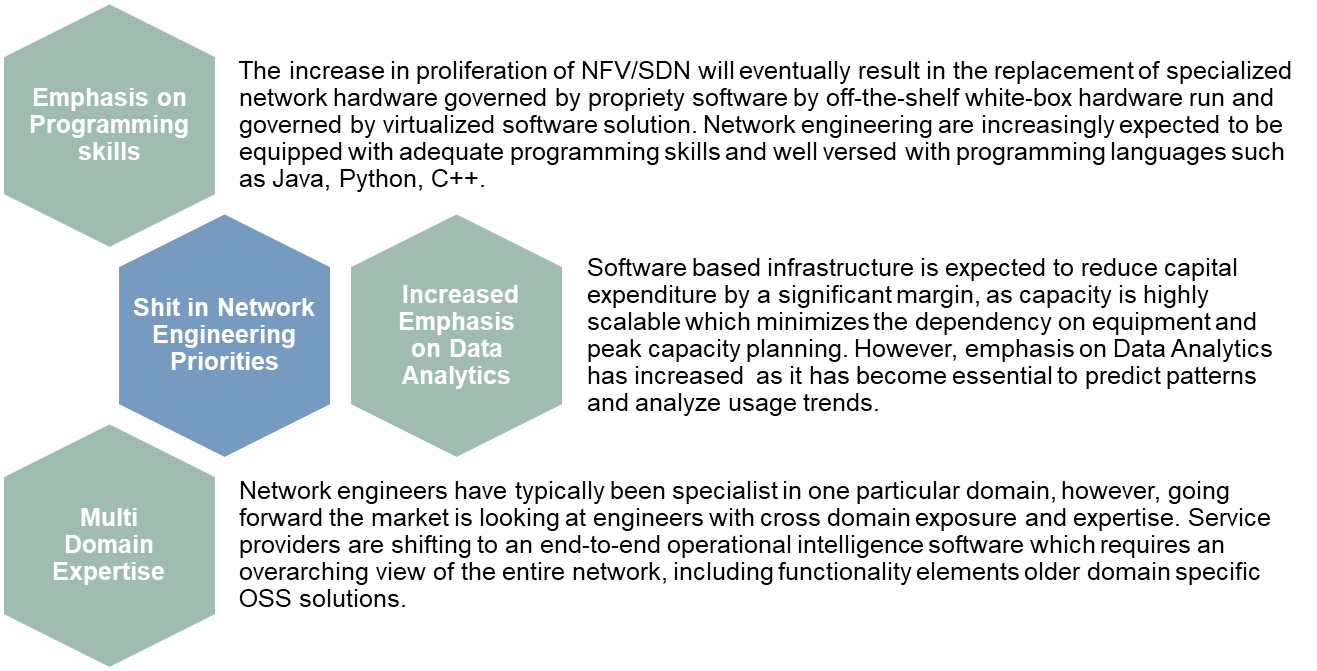
How Has SDN and NFV Transformed the Communication Service Provider Landscape?

SDN/NFV Current Market Scenario
The software defined market/network functions virtualization (SDN/NFV) has been showing a high growth rate over the past couple of years, and is expected to have similar growth patterns through 2020, to reach more than $15 billion by 2020.
The shift in network approach is expected to affect the communication service provider (CSP) landscape at multiple levels. For instance, skillset requirement has been evolving over the past couple of years with an impact on the staffing patterns in the organization. As regards operations, the approach can reduce CAPEX, shorten the provisioning timeline, and pave the way for automation. By implementing SDN/NFV, CSPs can deliver improved, reliable, and consistent network quality with increased flexibility to the end user.
SDN can also offer direct cost savings by reducing the total cost of operation, and indirect savings by reducing the operation costs by minimizing the network faults and fault correction time.
Benefits of SDN/NFV solutions

SDN/NFV platforms are expected to offer open source-based frameworks with increased flexibility and scalability, enabling CSPs to reach markets faster while not compromising on the network quality and reliability. Most platforms offer integration with legacy systems to extract the maximum out of existing networks, reducing the need to replace the entire network to enjoy NFV benefits. The integration and adoption of open source-based software platforms can reduce the CSP dependency on equipment or vendor, enabling the integration of multivendor devices and third-party applications by increasing interoperability and promoting the usage of white label network equipment.
These are expected to support all current revenue streams and services as well as enable the CSP to make the best use of new and upcoming revenue opportunities. Such platforms are expected to increase the agility of networks, enabling service providers to cater to fluctuating demand while supporting the rapid expansion of networks catering to new opportunities. Networks based on such platforms are essential for the traditional service provider to transition to the net gen service provider and compete effectively with other communication and OTT service providers. To add to the primary benefits that SDN/NFV-based platforms promise, they can increase the security of networks by providing role-based user access; integrating the existing, new, and mixed-wavelength services; and supporting disaster recovery and delivery dynamic service activation and end-to-end provisioning.
Impact on Revenue Services and Revenue Streams

SDN/NFV-based networks are what the future of networks are expected to be, with various services and revenue streams within the CSP landscape. However, the impact is phase-wise, time-based, step-by-step progression, and not an instantaneous jump from one way of working to another. The above illustration is based on network publication and industry experts’ views on the impact of services/revenues and the time it would take for realization.
The current frameworks can extract the most from low-hanging fruits such as customer experience and automated upselling, and support the growth of new organic service lines. The largest impact is expected in the M2M/IoT space, enabling service providers to offer or transition to new service lines, although the implementation of these are expected to take much longer.
Using SDN/NFV to Modify the Central Office (CORD)
The basic aim of this approach is to equip the central office with SDN, NFV, and cloud, making them an integral part of the CSPs’ cloud strategy. Typically, cloud economies and agility are experienced at the network edge. This approach predominantly transitions these flexibilities and benefits to the central office through SDN, NFV, and elastic cloud services, which typically run on commodity hardware. The architecture can support a wide-variety of services, including access services such as fiber-to-the-home and scalable cloud services (SaaS), the services implemented in the data and control planes, the trusted operator-provided services and untrusted third-party services, and bundled legacy services and disaggregated Greenfield services.
The architecture typically uses commodity hardware, which is basically a collection of commodity servers interconnected by white label switches. Proprietary and closed hardware networks are replaced by commoditized connectivity connecting millions of subscribers to the Internet with an open, software-defined solution. The software component of the architecture is a set of open source platforms such as OpenStack, Docker, ONOS, and XOS.
Implementation takes a phase-wise approach, predominantly consisting of two stages. The first stage is virtualization of devices, where the hardware components are virtually overlaid into software components running on commodity hardware (for instance, in the GPON network, the OLT is virtualized, followed by the customer premise equipment and BNG). The second stage is providing a framework in which these virtualized components can be seamlessly integrated into the cloud services that the service provider wants to execute, leading to a coherent end-to-end system.
Every transformational process always comes with associated benefits and key challenges. Cost minimization is one of the key benefits; for instance, in GPON, OLT, CPE, and BNG contribute to significant capital investment, which can be drastically reduced by virtualizing them. The key challenge is the actual execution of the transform, consisting of the systematic process of converting the functions of the diverse collection of proprietary vendor equipment into software components on a white box. The process is easier said than done, although the vendors promise seamless and easy implementation, and the execution can lead to more unknown bottlenecks than expected.
SDN/NFV Impact on Staffing Requirements
The telecom industry is shifting from their traditional method of working in silos to a unified approach, all enabled through SDN/NFV and the infinite possibilities they promise. The skill set requirement is gradually changing, and is expected to bring about a new set of challenges for recruitment and staffing, as organizations will be looking to bridge the gap between the existing and the expected.

Programming skills and cross-domain expertise will become highly sought for, and, as in all industries, data analytics is expected to alter the expectation and perception of companies and their recruiters. Organizations are now looking for general specialists who can cover different domains and make themselves relevant with the current technology and have the potential to scale up the next generation technologies and future development.
Conclusion
Programmable and automated virtual networks will be the standard operating model for most CSPs in the future as it progressively decreases the dependency on network equipment vendors and limits the impact of their proprietary software. The implementation of these frameworks will increase transparency and visibility of the network and enable real-time performance monitoring and automation of repetitive tasks almost instantaneously. SDN/NFV is still in its early stages, and the impact of the solution is prevalent more in the expected than experienced space. In the long run, these frameworks will have high impact on the emerging technology trends and equip CSPs to handle the future more effectively and efficiently. Increased flexibility and scalability to cater to rapid peaks, faster marketing with shorter provisioning timelines, automation, and cost minimization are the key drivers propelling the growth and adoption of these frameworks.
Related Insights:
View All
Get more stories like this
Subscirbe for more news,updates and insights from Beroe







